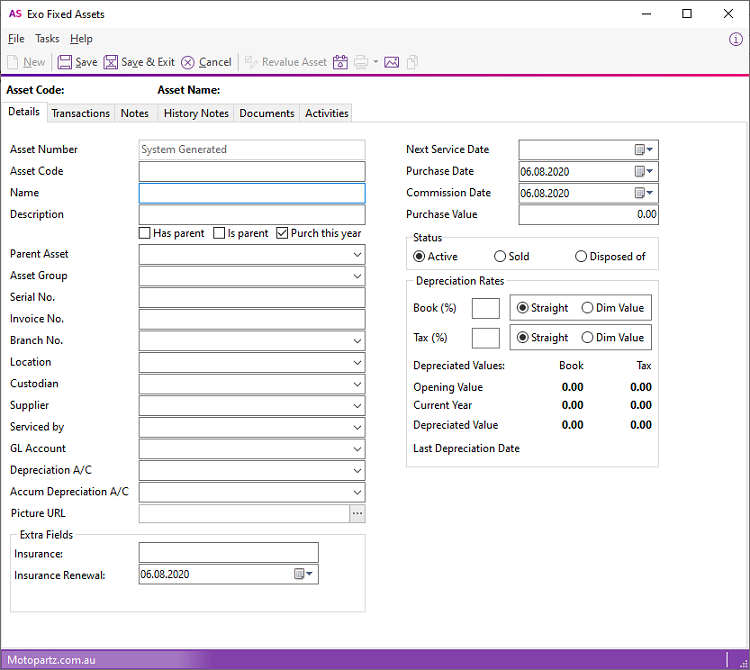Adding an Asset
Record newly-acquired fixed assets in the General Ledger first. A creditor’s invoice for the purchase of a fixed asset is charged to a GL Fixed Asset cost account, then the asset is added to the Fixed Assets register.
To add an asset to Fixed Assets:
-
Double click on an asset in the General Ledger Assets window (or select the asset and click Add).
-
Click New on the Asset Search widget or the Fixed Assets window.
The Fixed Assets window displays, with the Details tab selected:

Enter values in all fields on the Details tab, then click Save.
Note: Adding an asset to Fixed Assets does not produce General Ledger accounting entries. The update to the General Ledger Asset Cost accounts is done independently. You must reconcile the GL Asset Cost accounts (and accumulated depreciation) to totals from Fixed Assets.
Asset Details
Enter this information for the asset:
|
Field |
Description |
|
Asset Number |
A unique identifier for the asset. This number is generated by Fixed Assets. You can't change it. |
|
Asset Code |
A code to identify the asset. |
|
Name |
The name of the asset. |
|
Description |
A description of the asset which appears in the General Ledger and on the invoice. |
|
Has parent |
Select this option if the asset is a part of a larger asset. |
|
Is parent |
Select this option if the asset is the main asset and has other subsidiary assets. |
|
Purch this year |
Select this option if the asset was purchased this year. |
|
Parent Asset |
If the Has parent option is selected, specify the asset's parent asset. You can only select assets with the Is parent option selected. |
|
Asset Group |
Select the Asset Group that the asset belongs to. This determines default values for General Ledger accounts and depreciation rates or methods. |
|
Serial No. |
The serial number of the asset (if applicable). |
|
Invoice No. |
The Creditor Invoice number. |
|
Branch No. |
The branch that the asset is located in. |
|
Location |
The location that the asset belongs in. |
|
Custodian |
The name of the staff member responsible for the asset. |
|
Supplier |
The name of the supplier who sold the asset to you. |
|
Serviced by |
The name of the person who will service the asset (if applicable). |
|
GL Account |
The Balance Sheet Asset Cost account number. |
|
Depreciation A/C |
The Profit & Loss Depreciation expense account. |
|
Accum Depreciation A/C |
The Balance Sheet Accumulated Depreciation account. |
|
Picture URL |
Click the edit button at the end of this field to select an image file for the asset. You can view the image by clicking the View Image button on the toolbar. |
|
Extra Fields |
Any Extra Fields that have been set up on the ASSET_REG table in positions 1 - 3 appear in this section. |
|
Next Service Date |
The date you on which services takes place (if applicable). |
|
Purchase Date |
The date the asset was purchased. |
|
Commission Date |
The date to start depreciating the asset. |
|
Purchase Value |
The price paid for the asset (excluding GST). |
|
Status |
Select whether the asset is Active (with you and being depreciated), has been Sold or has been Disposed of. |
|
Depreciation Rates |
|
|
Book [%] |
The book/accounting depreciation rate. |
|
Tax [%] |
The tax depreciation rate. |
|
Straight |
Select this option if you use the Straight Line depreciation method for this asset. |
|
Dim Value |
Select this option if you use the Diminishing Value depreciation method for this asset. |
|
Depreciated Values (all read-only) |
|
|
Opening Value |
The opening Net Book Value for the current year. |
|
Current Year |
The amount that the asset has depreciated by this year. |
|
Depreciated Value |
The current Net Book Value of the asset (equal to Opening Val - Current Year). |
|
Last Depreciation Date |
The date when depreciation was last calculated on the asset. |
Additional Tabs
Additional information and functions are available on the other tabs on the Fixed Assets window:
-
Extra Fields - the Extra Fields that have been set up on the ASSET_REG database table in position 4 and onwards appear on this tab.
-
Transactions - this tab contains a dashboard with the Asset Transactions widget to displays transactions related to the asset.
-
Notes - enter information about the asset.
-
History Notes - add, edit and delete more formal notes about the asset.
-
Documents - add external documents to the asset account. You can open the Document Manager utility from this window, and add documents to the tab by dragging them onto the tab.
-
Activities - add tasks or appointments relating to the asset.
Note: Widgets on the Transaction dashboard can use the Current Asset parameter (@CURRENT_ASSET) to display data specific to the asset being edited.
